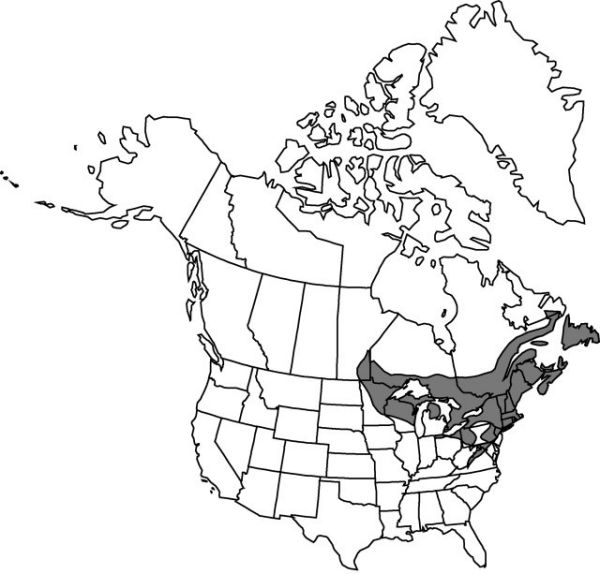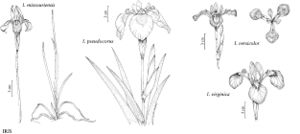Difference between revisions of "Iris versicolor"
Sp. Pl. 1: 39. 1753.
FNA>Volume Importer |
imported>Volume Importer |
||
| Line 8: | Line 8: | ||
}} | }} | ||
|common_names=Blue flag;iris versicolore | |common_names=Blue flag;iris versicolore | ||
| + | |special_status={{Treatment/ID/Special_status | ||
| + | |code=W2 | ||
| + | |label= | ||
| + | }}{{Treatment/ID/Special_status | ||
| + | |code=W1 | ||
| + | |label= | ||
| + | }}{{Treatment/ID/Special_status | ||
| + | |code=F | ||
| + | |label=Illustrated | ||
| + | }}{{Treatment/ID/Special_status | ||
| + | |code=E | ||
| + | |label=Endemic | ||
| + | }} | ||
|basionyms= | |basionyms= | ||
|synonyms= | |synonyms= | ||
| Line 45: | Line 58: | ||
|publication title=Sp. Pl. | |publication title=Sp. Pl. | ||
|publication year=1753 | |publication year=1753 | ||
| − | |special status= | + | |special status=W2;W1;Illustrated;Endemic |
| − | |source xml=https:// | + | |source xml=https://bibilujan@bitbucket.org/aafc-mbb/fna-data-curation.git/src/bb6b7e3a7de7d3b7888a1ad48c7fd8f5c722d8d6/coarse_grained_fna_xml/V26/V26_799.xml |
|genus=Iris | |genus=Iris | ||
|subgenus=Iris subg. Limniris | |subgenus=Iris subg. Limniris | ||
Revision as of 22:21, 27 May 2020
Rhizomes pale pinkish white, freely branching, forming large clumps, 1–2.5 cm diam., clothed with remnants of old leaves; roots fleshy. Stems 1–2-branched, solid, 2–6 dm. Leaves: basal with blade green to grayish green, often purplish basally, centrally thickened in mature leaves, prominently veined, narrowly ensiform, 1–8 dm × 1–3 cm; cauline 1–2, blade linear-lanceolate, seldom equaling stem. Inflorescences compact, units 2–4-flowered; spathes never foliaceous, 3–6 cm, unequal, outer shorter than inner, thickly chartaceous to scarious, margins shiny, darker in color. Flowers: perianth violet-blue to rarely white; floral tube funnelform, constricted above ovary, 1–1.2 cm; sepals ovate to reniform, 4–7.2 × 1.8–4 cm, base abruptly attenuate, signal a pubescent, greenish or greenish yellow patch surrounded by heavily veined purple on white at base of blade; petals lanceolate to oblong-lanceolate, 2–5 × 0.5–2 cm, much shorter than sepals, firm, apex rarely emarginate; ovary rounded-triangular in cross section, somewhat inflated, 0.8–2 cm; style 3–3.5 cm, base not auriculate, margins entire or toothed, crests reflexed, 0.7–1.5 cm; stigmas unlobed, triangular or rounded-triangular, margins entire; pedicel 2–8 cm, frequently exceeding spathe. Capsules often persistent over winter, ovoid to oblong-ellipsoid, conspicuously beaked, obtusely triangular in cross section, 1.5–6 cm, tardily dehiscent. Seeds dark brown, D-shaped, 5–8 mm, shiny, thin, hard, regularly pebbled, not corky. 2n = 108.
Phenology: Flowering May–Jul.
Habitat: Marshy places, along roadsides, shores, and along mountains
Distribution

Man., N.B., Nfld. and Labr., N.S., Ont., P.E.I., Que., Conn., Maine, Md., Mass., Mich., Minn., N.H., N.J., N.Y., Ohio, Pa., R.I., Vt., Va., Wis.
Discussion
E. Anderson (1936) showed rather conclusively that Iris versicolor arose as an amphidiploid between I. virginica (n = 35) and I. hookeri (I. setosa var. canadensis) (n = 19). Back-cross hybrids have been produced both ways: I. virginica × I. versicolor producing Iris ×robusta E. S. Anderson, and I. versicolor × I. hookeri producing I. ×sancti-cyri J. Rousseau.
Iris versicolor is becoming a weed in New Brunswick, Prince Edward Island, and Nova Scotia. Livestock will not eat iris foliage, but feed voraciously on the competition, thus giving the irises plenty of room to expand.
Selected References
None.
